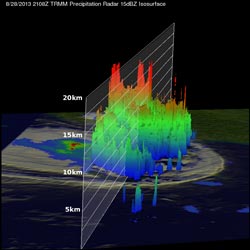NASA's TRMM Sees Heavy Rain Over Taiwan from Tropical Storm Kong-Rey

The TRMM satellite measured Tropical Storm Kong-Rey's rainfall at a rate of over 205mm/8 inches per hour in intense bands of rain over southwestern Taiwan on August 28. Kong-Rey's location is shown with a red symbol. <br><br>Image Credit: SSAI/NASA, Hal Pierce<br>
Flooding from torrential rainfall with totals of over 500 mm (~19.7 inches) have been reported in western Taiwan.
A rainfall analysis from TRMM's Microwave Imager (TMI) and Precipitation Radar (PR) instruments revealed that precipitation was falling was at a rate of over 205mm/8 inches per hour in intense bands of rain over southwestern Taiwan.
TRMM data was used to create a 3-D image looking from the east, showed the extremely high storms located on the western side of Taiwan.
TRMM showed that the tops of those powerful thunderstorms were often reaching heights above 16.5 km (~10.3 miles).
On Aug. 30 at 1500 UTC/11 a.m. EDT, Kong-Rey had weakened to a tropical depression with maximum sustained winds near 30 knots/34.5 mph/55.5 kph. It had passed Taiwan and was centered near 31.7 north and 126.6 east, about 251 nautical miles/288 miles/465 km west-southwest of Sasebo, Japan. Kong-Rey was moving northeastward at 13 knots/15 mph/20.9 kph.
Tropical Depression Kong-Rey is now predicted to move to the north then northeast and remain just off the western coast of Japan until it makes a brief landfall near Misawa in the north on Sept. 1. Resident along western Japan can expect showers, gusty winds and rough surf over the next several days.
Text credit: Rob Gutro
NASA's Goddard Space Flight Center
Media Contact
All latest news from the category: Earth Sciences
Earth Sciences (also referred to as Geosciences), which deals with basic issues surrounding our planet, plays a vital role in the area of energy and raw materials supply.
Earth Sciences comprises subjects such as geology, geography, geological informatics, paleontology, mineralogy, petrography, crystallography, geophysics, geodesy, glaciology, cartography, photogrammetry, meteorology and seismology, early-warning systems, earthquake research and polar research.
Newest articles

Properties of new materials for microchips
… can now be measured well. Reseachers of Delft University of Technology demonstrated measuring performance properties of ultrathin silicon membranes. Making ever smaller and more powerful chips requires new ultrathin…

Floating solar’s potential
… to support sustainable development by addressing climate, water, and energy goals holistically. A new study published this week in Nature Energy raises the potential for floating solar photovoltaics (FPV)…

Skyrmions move at record speeds
… a step towards the computing of the future. An international research team led by scientists from the CNRS1 has discovered that the magnetic nanobubbles2 known as skyrmions can be…




















